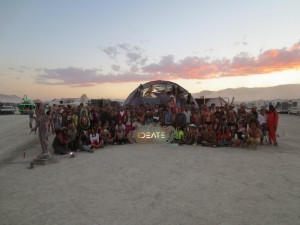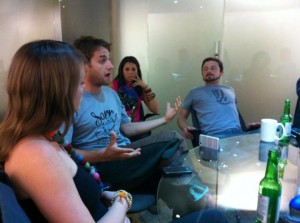Hear more about this story and how it developed on the Peninsula Report podcast >>

The annual Burning Man festival, long associated with a week of art, anarchy and communal living in the Black Rock Desert of Nevada, is on the verge of change.
While transitioning the project to nonprofit status, Burning Man’s directors are exploring ways to expand its culture globally, focus more on technology and innovation, and lean heavily on the ideas of young Silicon Valley entrepreneurs. “We’re at an absolutely critical time in our change and our morphing, and we’re going to be relying on others to help us,” said Marian Goodell, one of the six project owners since 1996.
Conversations about the future have been brewing for months. Bear Kittay, a 27-year-old entrepreneur and musician, has taken the lead in organizing meetings for up-and-coming Bay Area start-up types with Larry Harvey, the founder and director of Burning Man, and Goodell. Kittay is also helping figure out how to spread the project’s 10 principles to other parts of the world.
Goodell calls Kittay their “hyper-connector.” His resume includes being the co-founder of a company called Organizer, which created a clipboard-like mobile platform for use during political campaigns, and a partner (and designated “social alchemist”) in the Avalon Hot Springs eco-resort north of Napa Valley.
Over Memorial Day weekend, Kittay organized a retreat at Avalon. He invited Harvey, Goodell and about a dozen others, including Luke Nosek, one of the founders of PayPal, and Evan Steiner, program manager of the collaboration facilitator Hub Bay Area. As Kittay put it, the retreat “set off epiphanies for many of us.”
Others prominent in discussions about the project’s future include James Hanusa, CEO of Urban Innovation Exchange in San Francisco, and Edward Zaydelman, co-founder of Puerta a la Vida, a wellness resort in Costa Rica.
There are longstanding cultural ties between Burning Man and Silicon Valley. It is no secret that Google’s founders are avid “burners,” with entire walls at the company’s Mountain View campus covered in photos from the festival. And the computer and technology industries are often the most represented among the professions of festival participants, according to the Black Rock City Census, which conducts an annual survey at Burning Man.
But the Avalon retreat initiated an active conversation between the two cultures and two generations of burners — baby boomers and millennials.
Those talks continued and led to the formation of the IDEATE innovation camp, which participated in this summer’s festival. Each camp has a different focus, such as dance, meditation and clothing swaps. IDEATE differed from typical camps, as it operated with an unprecedented mission: to be “an [ideas] incubator in the center of Burning Man,” according to Kittay.
Kittay said IDEATE brought together bright minds to figure out how to offer the tools of Burning Man culture, including collaboration, sustainability and inclusion, to start-up projects around the world.
Burning Man founders paid special attention to IDEATE, which was given a block of tickets even though the idea emerged long after tickets were sold out. Goodell placed the camp close to First Camp, where the founders make their desert home each year.
Goodell said her thought was, “We should take all this brain power around us in San Francisco—dot-com and entrepreneurs…[who] care about Burning Man, and let’s get them all together…and see whether anything could come of it.”

The majority of the 210 people who camped at IDEATE were new to Burning Man and were young entrepreneurs from companies such as TED, a nonprofit committed to spreading worthwhile ideas; Summit, which hosts an annual four-day event for 1,000 of the world’s leading change makers; and Singularity University, which seeks to educate a new generation of leaders in technologies that will exponentially advance human capability in years to come.
Three salons were held throughout the week to formally discuss the future of Burning Man, and many of IDEATE’s members attended. But Tim West, a chef/entrepreneur who cooked meals for IDEATE during the festival, said it wasn’t just a lot of talk. “IDEATE, first and foremost, was to create that space to have those conversations, but secondly, to create systems that help people take ideas to reality,” he said.
One San Francisco-based organization that camped at IDEATE—called ReAllocate—did just that. The group’s members brought giant shipping containers and partnered with other companies like 3D Systems and Cubify to make models of people using three-dimensional scanners and delivered them across the desert via drones like in a science fiction movie.
It was a trial for an innovative way to quickly bring vaccines to people in remote parts of the world. “Now that we’ve done a proof of concept, [the question is] where do we start implementing something like that?” said Timothy Lipton, the co-founder of ReAllocate with Mike North.
The need for collaboration with the younger generation of burners was clear to Goodell, especially as Burning Man moves from being for-profit to nonprofit. The work to become a nonprofit organization by 2013 has been ongoing for two years, according to Goodell.
Serving the public good in this age of digital technology and rapid communication, she said, requires the input of the millennials, who have what Goodell called an entrepreneurial spirit and a thirst for sharing ideas. They’re also the ones who are representing more and more of the Burning Man population each year. In 2011, almost half of Burning Man participants were under 30, according to the Black Rock City Census.
Larry Harvey is in his sixties; Goodell just turned 50. She said the founders should look to hire young people, and young people should step up and “infiltrate the organization and be ready to take things over…and change the world.”
Goodell described Kittay as “not unlike Larry.” She called them both “pied pipers,” saying that, although neither is likely to be “the first one to hammer up a tent stake,” they both “can get really enthusiastic around ideas, and then people want to gather around and help.” Kittay called himself an “API” for Burning Man: an application programming interface, or an application that helps data communicate across different software. Currently, he is a volunteer for the organization, but Goodell expressed her desire to compensate him if he keeps up all the work.
But Goodell issued a caveat concerning IDEATE and the millennial entrepreneurs as a group: They will be given more influence in the organization only if they do something with all their ideas. They need to maintain momentum and prove themselves as able to make it happen, rather than just talk about it, she said.
After the desert festival, which is held from late August to early September, Kittay traveled with Harvey and Goodell to Turkey, where they considered ancient history and its ties to modern life and talked about ways to make global expansion a reality.
There is talk of bringing Burning Man ambassadors to design projects and businesses across the world; holding urban and rural retreats in addition to the existing “regional burns,” or smaller-scale festivals; creating a social network for burners; crowd-funding design endeavors and sharing technologies that will help the world utilize some of Burning Man’s principles as tools, such as “radical inclusion” and “leave no trace behind.”
Will Roger, one of the six Burning Man Project owners, is heading up the development of a new property called Fly Ranch, which is designed to serve as an art park and idea incubator, particularly for the development of green technology.

Fly Ranch is a 4,000-acre site with natural geysers about 10 miles from the spot in the Black Rock Desert where the festival is held each year. Plans for the property include a conference center, a camping ground and the largest open-air art gallery and sculpture park in the world. Roger called it a model for cultural centers of the future “that we could use to have more of an influence in the culture of the world.”
A Nevada family currently owns the Fly Ranch property, and the Burning Man organization is trying to raise the $7 million needed to purchase it. They are close to reaching their goal, Roger said.
The Fly Ranch property represents another shift in Burning Man as the world knows it. Traditionally the project has been “below the radar,” said Kittay. But now is the time that Burning Man is ready to reveal itself as more than just “electronic, dubstep, naked—whatever associations that people have had superficially with it, and move into much more the space of what it truly is at its core,” he said. That core, according to Kittay, is built around “the philosophical principles of collaboration and of incubating human culture and community and experience.”
Ahough the organization as a whole supports change, some staff members have been a bit hesitant to make any big leaps, including Harvey himself, observed Kittay, who said Harvey “has really guarded Burning Man, and the identity and philosophical center of Burning Man, from many, many people who, whether intentionally or unintentionally, would put it in harm’s way.”
As the project expands globally into “a capitalist world,” Kittay cautioned, “it could so quickly lose its essence.” The Peninsula Press could not reach Harvey for comment.
Goodell calls this moment pivotal. “There’s before IDEATE, and there’s after IDEATE, and then there’s 2013,” she said.
Peninsula Press reporter Xandra Clark attended Burning Man in 2012.
[soundcloud url=”http://api.soundcloud.com/tracks/76837302″ params=”” width=” 100%” height=”166″ iframe=”true” /]
